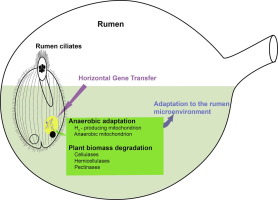当前位置:
X-MOL 学术
›
Mol. Phylogenet. Evol.
›
论文详情
Our official English website, www.x-mol.net, welcomes your feedback! (Note: you will need to create a separate account there.)
Single-cell transcriptome sequencing of rumen ciliates provides insight into their molecular adaptations to the anaerobic and carbohydrate-rich rumen microenvironment.
Molecular Phylogenetics and Evolution ( IF 4.1 ) Pub Date : 2019-11-15 , DOI: 10.1016/j.ympev.2019.106687 Jin-Mei Feng 1 , Chuan-Qi Jiang 2 , Zong-Yi Sun 3 , Cong-Jie Hua 1 , Jian-Fan Wen 4 , Wei Miao 5 , Jie Xiong 3
Molecular Phylogenetics and Evolution ( IF 4.1 ) Pub Date : 2019-11-15 , DOI: 10.1016/j.ympev.2019.106687 Jin-Mei Feng 1 , Chuan-Qi Jiang 2 , Zong-Yi Sun 3 , Cong-Jie Hua 1 , Jian-Fan Wen 4 , Wei Miao 5 , Jie Xiong 3
Affiliation

|
Rumen ciliates are a specialized group of ciliates exclusively found in the anaerobic, carbohydrate-rich rumen microenvironment. However, the molecular and mechanistic basis of the physiological and behavioral adaptation of ciliates to the rumen microenvironment is undefined. We used single-cell transcriptome sequencing to explore the adaptive evolution of three rumen ciliates: two entodiniomorphids, Entodinium furca and Diplodinium dentatum; and one vestibuliferid, Isotricha intestinalis. We found that all three species are members of monophyletic orders within the class Litostomatea, with E. furca and D. dentatum in Entodiniomorphida and I. intestinalis in Vestibuliferida. The two entodiniomorphids might use H2-producing mitochondria and the vestibuliferid might use anaerobic mitochondria to survive under strictly anaerobic conditions. Moreover, carbohydrate-active enzyme (CAZyme) genes were identified in all three species, including cellulases, hemicellulases, and pectinases. The evidence that all three species have acquired prokaryote-derived genes by horizontal gene transfer (HGT) to digest plant biomass includes a significant enrichment of gene ontology categories such as cell wall macromolecule catabolic process and carbohydrate catabolic process and the identification of genes in common between CAZyme and HGT groups. These findings suggest that HGT might be an important mechanism in the adaptive evolution of ciliates to the rumen microenvironment.
中文翻译:

瘤胃纤毛的单细胞转录组测序提供了对它们对厌氧和富含碳水化合物的瘤胃微环境的分子适应性的见解。
瘤胃纤毛虫是专门在厌氧,富含碳水化合物的瘤胃微环境中发现的一组纤毛虫。然而,纤毛虫对瘤胃微环境的生理和行为适应的分子和机理基础是不确定的。我们使用单细胞转录组测序来探索三种瘤胃纤毛虫的适应性进化:两种Entodiniomorphids,Entodinium furca和Diplodinium dentatum;和一个前卫的肠毛虫(Isotricha intestinalis)。我们发现这三个物种都是Litostomatea类中的单系成员,在Entodiniomorphida中有E. furca和D. dentatum,在Vestibuliferida中有I. intestinalis。两个Entodiniomorphids可能使用产生H2的线粒体,而vestibuliferid可能使用厌氧性线粒体在严格的厌氧条件下生存。而且,在包括纤维素酶,半纤维素酶和果胶酶的所有三个物种中鉴定了碳水化合物活性酶(CAZyme)基因。这三个物种均已通过水平基因转移(HGT)获得了原核生物衍生的基因以消化植物生物质的证据包括大量的基因本体论类别,例如细胞壁大分子分解代谢过程和碳水化合物分解代谢过程,以及之间的共同基因鉴定CAZyme和HGT组。这些发现表明,HGT可能是纤毛对瘤胃微环境适应性进化的重要机制。这三个物种均已通过水平基因转移(HGT)获得了原核生物衍生的基因以消化植物生物质的证据包括大量的基因本体论类别,例如细胞壁大分子分解代谢过程和碳水化合物分解代谢过程,以及之间的共同基因鉴定CAZyme和HGT组。这些发现表明,HGT可能是纤毛对瘤胃微环境适应性进化的重要机制。这三个物种均已通过水平基因转移(HGT)获得了原核生物衍生的基因以消化植物生物质的证据包括大量的基因本体论类别,例如细胞壁大分子分解代谢过程和碳水化合物分解代谢过程,以及之间的共同基因鉴定CAZyme和HGT组。这些发现表明,HGT可能是纤毛对瘤胃微环境适应性进化的重要机制。
更新日期:2019-11-18
中文翻译:

瘤胃纤毛的单细胞转录组测序提供了对它们对厌氧和富含碳水化合物的瘤胃微环境的分子适应性的见解。
瘤胃纤毛虫是专门在厌氧,富含碳水化合物的瘤胃微环境中发现的一组纤毛虫。然而,纤毛虫对瘤胃微环境的生理和行为适应的分子和机理基础是不确定的。我们使用单细胞转录组测序来探索三种瘤胃纤毛虫的适应性进化:两种Entodiniomorphids,Entodinium furca和Diplodinium dentatum;和一个前卫的肠毛虫(Isotricha intestinalis)。我们发现这三个物种都是Litostomatea类中的单系成员,在Entodiniomorphida中有E. furca和D. dentatum,在Vestibuliferida中有I. intestinalis。两个Entodiniomorphids可能使用产生H2的线粒体,而vestibuliferid可能使用厌氧性线粒体在严格的厌氧条件下生存。而且,在包括纤维素酶,半纤维素酶和果胶酶的所有三个物种中鉴定了碳水化合物活性酶(CAZyme)基因。这三个物种均已通过水平基因转移(HGT)获得了原核生物衍生的基因以消化植物生物质的证据包括大量的基因本体论类别,例如细胞壁大分子分解代谢过程和碳水化合物分解代谢过程,以及之间的共同基因鉴定CAZyme和HGT组。这些发现表明,HGT可能是纤毛对瘤胃微环境适应性进化的重要机制。这三个物种均已通过水平基因转移(HGT)获得了原核生物衍生的基因以消化植物生物质的证据包括大量的基因本体论类别,例如细胞壁大分子分解代谢过程和碳水化合物分解代谢过程,以及之间的共同基因鉴定CAZyme和HGT组。这些发现表明,HGT可能是纤毛对瘤胃微环境适应性进化的重要机制。这三个物种均已通过水平基因转移(HGT)获得了原核生物衍生的基因以消化植物生物质的证据包括大量的基因本体论类别,例如细胞壁大分子分解代谢过程和碳水化合物分解代谢过程,以及之间的共同基因鉴定CAZyme和HGT组。这些发现表明,HGT可能是纤毛对瘤胃微环境适应性进化的重要机制。



























 京公网安备 11010802027423号
京公网安备 11010802027423号